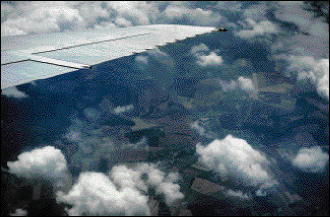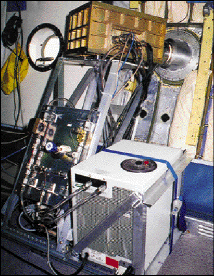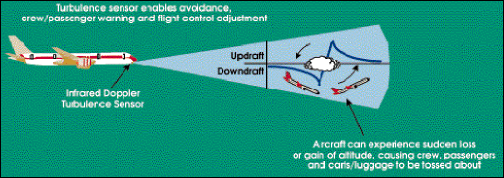When commercial flights run into turbulence, the result is usually nothing more than spilled drinks and jostled nerves. However, as the recent incident on United Airlines Flight 826 revealed, sometimes the effects of turbulence can be deadly. Atmospheric conditions undetected by the plane's navigational system caused the Boeing 747 to drop more than 100 feet, killing one and injuring at least 100 others.

According to its developers, the proposed onboard turbulence detector can provide advanced warning of strong clear-air turbulence.
|
Photonics' contribution in preventing such incidents lies in light detection and ranging technology, also known as laser radar or lidar, and the solution cannot come too soon. According to Federal Aviation Administration (FAA) statistics, between 1980 and 1995, clear-air turbulence, similar to that experienced by Flight 826, injured 316 and killed two, and mishaps related to turbulence cost US airlines approximately $100 million annually. More than ever before, this most recent event illustrates that the airline industry needs a reliable sensor technology to monitor these kinds of "invisible" dangers.
Some turbulence results from visible storms, and is therefore easy to detect with radar. In clear-air turbulence, up- or downdrafts of wind occur in clear skies, so radar and visual aids are useless. Currently, the only ways to deal with clear-air turbulence are to rely on recent reports from other pilots, sketchy meteorological data, or simply to buckle up at all times in case a plane hits an unexpected air bubble.

Despite innovations in aviation technology, clear-air turbulence detection remains one of the most daunting problems in the industry.
|
The problem with pilot reports is that they quickly become obsolete because turbulence events are sporadic and short-lived, said John McCarthy, manager of scientific and technical program development at the Naval Research Laboratory in Monterey, Calif. Researchers have developed sensors based on numerical models, but such devices identify a general area, and are imprecise.
Lidar probes IR spectrum
An effort to create a more reliable solution is being sponsored by NASA and the FAA. Coherent Technologies Inc. of Boulder, Colo., working with NASA's Aviation Safety Program, is using existing ground-based technology as a guide to develop a Doppler lidar system that detects clear-air turbulence at commercial airline cruise altitudes, typically 25,000 to 45,000 feet. Coherent Technologies already sells the ground-based version of the instrument, the WindTracer, for meteorological and military applications (See "Lidar Hits the Spot," Photonics Spectra, May 1996, page 21).
The system uses a 2-µm Tm:YAG infrared beam that reflects off small particles and aerosols in the air, which backscatter the light into a sensor. That light shifts in frequency as a result of the aircraft's motion relative to the particles. By analyzing the frequency of the reflected light, the system can determine the wind velocity at selected points along the beam path. Highly variable velocities along the laser beam indicate the presence of clear-air turbulence.
This is an improvement over current lidar technology, which uses a CO2 beam with a wavelength of 10 µm. According to Rodney K. Bogue, staff scientist at NASA's Dryden Research Center in Edwards, Calif., the ability to detect tiny particles is crucial, because particles found at higher altitudes are not only smaller, but fewer and farther between.


Coherent Technologies and NASA will test the Doppler lidar system prototype this spring.
|
That might not seem like a lot of time to reroute an airplane, but it allows some time to warn passengers to return to their seats. Bogue said that the plane's control mode, or autopilot, might have time to switch from an altitude hold, where the plane makes adjustments to maintain its altitude, to an attitude hold, where a plane changes altitude to maintain its attitude -- the orientation of the plane's axes relative to the horizon. He added that 6 to 30 seconds might have been enough to avoid some of the fatal and severe injuries incurred during the United 826 flight.
More development needed
Another advantage of the new lidar system is that it is much more eye-safe than its CO2-based counterpart because the eye is more tolerant of energy in this region of the spectrum, Bogue said. Also, since the new device uses a solid-state laser rather than a gas laser, it is more durable and better suited for airborne applications.
The path to developing a lidar-based sensor is not without its own bumps. There are doubts that there are enough aerosols at high altitudes to make a laser radar instrument functional. And even if it works, experts are skeptical that the system would give enough warning to make a difference. "You can't even turn your head in six seconds, let alone get in your seat and fasten your seat belt," McCarthy said.
The team has scheduled a test flight for the prototype on board a Lockheed Electra four-engine turbo-prop plane in April. Bogue said that the aircraft is ideal for testing because it is well-instrumented and can corroborate the measurements made by the lidar system. The researchers plan subsequent tests aboard a NASA DC-8.
Scientists estimate that if all goes well with the airborne tests, funding and government approvals, commercial airlines could begin implementing the infrared Doppler laser radar in the next three to five years. But implementation presents problems relating to time and expense. Industry insiders believe that if aircraft manufacturers started now to install the device in new planes, it would be 20 to 30 years before every plane in the country carried the system, and retrofitting existing fleets would take about 10 years and cost around $100,000 to $200,000 per plane. "Resources are scant, but if the government wants to heed the call to action, it has to make turbulence a priority," McCarthy said.
He believes that an interim solution might be to enforce the use of seat belts for both passengers and crew. "I get distressed when there's a lot of turbulence and the flight crew is still serving drinks," he said.